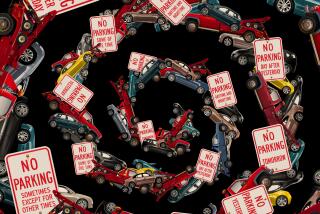Decals to Prevent Car Theft Catch On : Security: Police issue yellow stickers allowing officers, without violating constitutional rights, to stop and question drivers in early morning hours.
- Share via
An anti-auto theft program that failed in Van Nuys three years ago for lack of public participation has attracted nearly 1,000 participants since it was recently relaunched throughout the San Fernando Valley, police said Monday.
Under the program, Valley motorists can place a small yellow decal on the back window of their car, as a signal to police that the owner agrees to allow officers to stop and question the driver if the car is being driven between 1 and 5 a.m., when police say most car thefts occur.
In 1989, police offered the program in the Van Nuys Division, but only 58 residents signed up, too few to put it into effect. Now, three weeks after the same program was relaunched Valley-wide, about 940 residents have enrolled, police officials said.
“At this point, people are really getting involved with that program,” said Lt. Joseph Garcia, adjutant to Deputy Chief Mark Kroeker. “It’s a good start, particularly with the holidays and people being busy and not being around.”
Garcia said his office has even received calls from residents outside the Valley who are interested in having the program extended to their areas.
The program, modeled after a similar anti-theft program started in 1986 in New York, is currently operating in areas patrolled by the Valley, the Harbor and West Los Angeles police divisions. Los Angeles officials have said they will consider extending it to the rest of the city if it succeeds in the Valley.
Called Combat Auto Theft, or CAT, it is based on the theory that during the early morning hours, when the driver is more likely to be a thief than to be the car’s owner, the sticker gives officers probable cause to stop the auto, which they otherwise could not do on constitutional grounds.
Police say Valley residents have signed up for the program mainly because of concern over the growing problem of car thefts.
“A lot of them have been victims of car thefts before,” said Officer John Vradenburg, a desk officer at the Devonshire Division, where 219 people signed up. “The first two days of the program were a madhouse here. . . .
“There was just a steady stream of people.”
Officer Ken Meyer of the Van Nuys Division, where 130 people signed up, said residents have told him that they fear car thieves.
“A lot more cars are being stolen, especially your foreign-made cars like Toyota and Nissans,” he said. “If it does get stolen, hopefully we can stop them before it gets stripped.”
The largest turnout of participants, about 400, came from the West Valley Division.
Valley residents have good reason to be concerned about car theft: The Valley has more vehicles reported stolen than any other city police bureau. As of Nov. 14, there were 19,476 vehicles reported stolen in the Valley this year--an increase of about 1.5% from 19,186 during the same period last year, according to the statistics.
To get a decal, car owners can go to any of the Valley’s five police stations and sign a form saying they do not normally drive during the early morning hours and that police are permitted to stop the car to make sure that it is not stolen.
Police said that in effect, the sticker gives police the probable cause needed to stop a car even if nothing appears amiss. The owner also waives his constitutional protection against unreasonable search and seizure.
Lt. Richard Blankenship, who oversees the Valley program, said the only participant who has been stopped and questioned so far has been Ken Worthen, a Woodland Hills resident who, ironically, was the first person to sign up for the program.
Worthen, a retired executive with the Southern California Gas Co., said he was heading west on Ventura Boulevard when he noticed the patrol car’s flashing red light from behind. “I thought, ‘What have I done now?’ ”
At first, Worthen said he thought he might have unwittingly run a stop sign. But he relaxed when police explained that they were merely checking to see if he was the registered owner of the car.
“It was good. There was no problem,” Worthen said.
The police officers stopped him at 1:15 a.m., he said, only 15 minutes after the self-imposed curfew began.
Blankenship said Worthen was returning home from a late meeting when police stopped him. After police determined that Worthen was the owner registered under the program, he was allowed to continue on his way without incident, he said.
Blankenship said he attributes the initial popularity of the program to positive publicity when the effort was first announced. “This program can’t begin to get off the ground unless it has good publicity,” he said.
More to Read
Sign up for Essential California
The most important California stories and recommendations in your inbox every morning.
You may occasionally receive promotional content from the Los Angeles Times.











